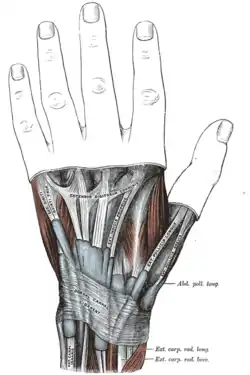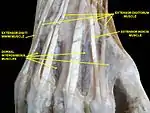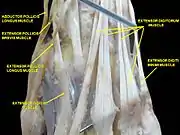Extensor digiti minimi muscle
The extensor digiti minimi (extensor digiti quinti proprius) is a slender muscle of the forearm, placed on the ulnar side of the extensor digitorum communis, with which it is generally connected.
| Extensor digiti minimi | |
|---|---|
 The synovial sheaths of the tendons on the back of the wrist. (Extensor digiti quinti proprius labeled at center left.) | |
| Details | |
| Origin | the anterior portion of the lateral epicondyle of the humerus (common extensor tendon) |
| Insertion | at the extensor expansion, located at the base of the proximal phalanx of digit V on the dorsal side |
| Artery | posterior interosseous artery |
| Nerve | posterior interosseous nerve (C7, 8) |
| Actions | extends the wrist and the little finger at all joints |
| Antagonist | Flexor digiti minimi brevis |
| Identifiers | |
| Latin | musculus extensor digiti minimi |
| TA98 | A04.6.02.044 |
| TA2 | 2506 |
| FMA | 38503 |
| Anatomical terms of muscle | |
It arises from the common extensor tendon by a thin tendinous slip and frequently from the intermuscular septa between it and the adjacent muscles.
Its tendon passes through a compartment of the extensor retinaculum, posterior to distal radio-ulnar joint, then divides into two as it crosses the dorsum of the hand, and finally joins the extensor digitorum tendon. All three tendons attach to the dorsal digital expansion of the fifth digit (little finger). There may be a slip of tendon to the fourth digit.
Variations
An additional fibrous slip from the lateral epicondyle; the tendon of insertion may not divide or may send a slip to the ring finger.
Absence of muscle rare; fusion of the belly with the extensor digitorum communis not uncommon.
Variations to the fifth extensor compartment, which the extensor digiti minimi runs through, may cause tenosynovitis and can limit the use of the extensor digiti minimi.
Extensor digiti minimi can also be bifurcated, which means split, at many different points in the muscle.
Functions
The extensor digiti minimi is a two joint muscle. It acts as an extensor in both joints. It extends the wrist, which means it moves the back of the hand toward the back of the forearm. It also extends the little finger, which means it straightens the little finger from a fist.
Additional images
 Bones of left forearm. Posterior aspect.
Bones of left forearm. Posterior aspect. Posterior surface of the forearm. Superficial muscles.
Posterior surface of the forearm. Superficial muscles. Transverse section across distal ends of radius and ulna.
Transverse section across distal ends of radius and ulna. Transverse section across the wrist and digits.
Transverse section across the wrist and digits. Extensor digiti minimi muscle
Extensor digiti minimi muscle Extensor digiti minimi muscle '
Extensor digiti minimi muscle ' Extensor digiti minimi muscle
Extensor digiti minimi muscle Muscles of hand. Posterior view.
Muscles of hand. Posterior view. Muscles of hand. Posterior view.
Muscles of hand. Posterior view.
References
This article incorporates text in the public domain from page 451 of the 20th edition of Gray's Anatomy (1918)
- Saladin, Kenneth S (2012). Anatomy & Physiology: the Unity of Form and Function (6th ed.). The McGraw-Hill. ISBN 978-0-07-337825-1.
- Tanaka, T; Moran, S; Zhao, C; Zobitz, ME; An, KN; Amadio, PC (Aug 2007). "Anatomic variation of the 5th extensor tendon compartment and extensor digiti minimi tendon". Clin. Anat. 20 (6): 677–82. doi:10.1002/ca.20480. PMID 17352412.
- Yoo, Moon-Jib; Chung, Kyung-Tae (December 2011). "Tendon impingement of the extensor digiti minimi: clinical cases series and cadaveric study". Clinical Anatomy. Wiley Periodicals. 25 (6): 755–61. doi:10.1002/ca.22017. PMID 22162183.